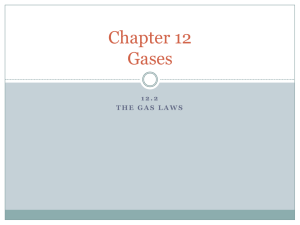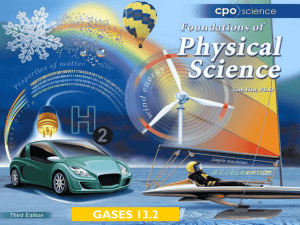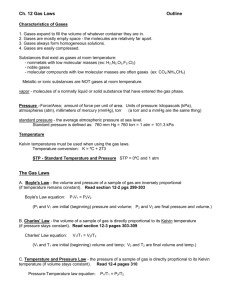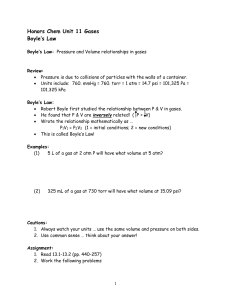Gas Properties and Laws
advertisement
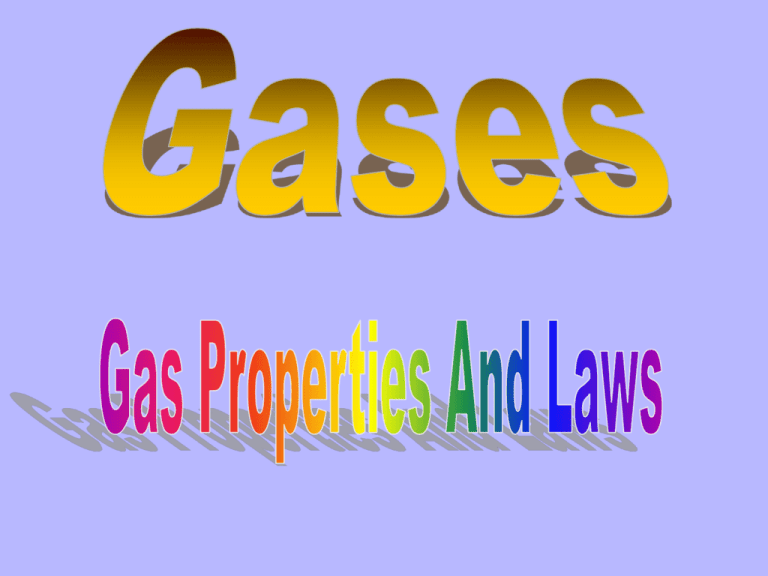
Gas Properties and Laws • Explains why gases act as they do. Assumptions/Postulates of the theory 1. Gases are composed of small particles. 2. These particles are in constant, straight-line, and random motion. 3. Collisions between these particles are elastic with each other. Nor do they exert attraction/repulsion on each other. 4. The average kinetic energy of the gas molecule is proportional to the temperature. Kinetic Molecular Theory: Basic Concepts 1. Volume: Gas molecules can be compressed therefore one volume is able to occupy a variety of volumes. Ex. How much CO2 gas is in a coke can? That same amount will fill a trash can. 2. Temperature: Since gases are “free” molecules, their energy is important. The temperature can determine how the gas will be or act. 3. Pressure: This affects gases a lot more than the other 2 states of matter. This can also define how the gas will act. Force is the mass being applied. Pressure is the mass being applied in a defined area. Pressure = Force/area Atmospheric pressure: The amount of pressure being exerted by the mass of a column of air over 1m2 of space. Weather: Low pressure means it is cloudy High pressure would be sunny Gas pressure is how often the molecules of the gas collide with the walls of its container. Barometers: this device is used to measure atmospheric pressure. Simple Barometer: this is a glass column going into a pool of mercury. As the atmospheric pressure pushes down on the Hg pool, it causes some to rise or fall in the column. When using a barometer, the mercury level is measured in the column. Thus the unit is mmHg The unit Torr is the same as mmHg The SI unit is the Pascal (Pa). But Kpa is more commonly used. For gas laws, the unit Atmospheres (atm) is used often. At sea level 1atm=101,325pa or 101.325kpa 760mmHg or 760torr 14.69lbs/in2 Manometer: is a device that is used to determine the pressure of a gas inside of a container. This device has a U-tube with a specific amount of Hg in it. The container of gas is hooked up to it and the gas is allowed to hit the Hg. The difference is the levels of Hg on both sides tells you the pressure of the gas. Closed ended: one end has a vacuum with a specific amount of pressure in it. Open ended: the atmospheric pressure is used. Manometers Open ended Closed ended Manometer variables: 1. Pressure of container 2. Pressure of atmosphere or vacuum 3. Height difference of Hg in tube In a manometer problem; you need to know at least 2 of 3 variables. You must also be sure that the pressures are in the same unit as the mmHg. You may need to do conversions. 1. A soccer ball is attached to an open-ended manometer. The mercury level in the manometer is 10.0 mm higher on the side attached to the ball than on the side open to the atmosphere. Atmospheric pressure has already been determined to be 770.0 mm Hg. What is the gas pressure in the ball? 2. A manometer contains a sample of nitrogen gas at a pressure of 88.3 kPa. The level of mercury in the U-tube is 12.8 mm lower on the end open to the atmosphere. What is the atmospheric pressure in torr? If you have an empty bottle is it really empty? (cap is off) Any gas trying to be collected into that bottle will simply mix with the other gases in air. Water displacement can be used to collect gases with absence of air, but there will be a small amount of water vapor. When you mix gases, each have a certain amount of pressure. This is called a Partial Pressure. Dalton’s law of partial pressure is for the total pressure of gases in a system. Ptotal = Pa + Pb + Pc http://www.wwnorton.com/chemistry/tutorials/interface.s wf?chapter=chapter_08&folder=daltons_law Boyle’s Law • Boyle’ Law describes the volume-pressure realationship. This is an inverse relationship: As you add pressure, volume decreases. Boyle’s law is expressed as: P1V1 = P2V2 Pressure units do not matter For this to happen though, temperature must be constant. Boyle's Law .. Animated If a bag of chips is filled with enough air to create a 1.5L bag at 101.3kpa in Kansas City. What volume will the bag be if it is taken to Denver at a pressure of 89.98kpa? Write Boyle’s law: P1V1 = P2V2 Next determine which numbers go together: 1.5L and 101.3kpa then ?L and 89.98kpa Finally substitute the numbers and solve for x: (101.3kpa)(1.5L) = (89.98kpa)(?L) X = 1.69L A 2.3L balloon is filled on the ground at 103.456kpa. The balloon is then taken in a plane that has a pressure of 67.8kpa, what is the volume of the balloon? A. 3.5L B. 1.5L C. 3049.7L D. Can not be determined with this info Kelvin scale of temperature: In the SI system, Kelvin is used since it does not have negative values. Zero Kelvin is called absolute zero. Zero Celsius = 273K Charles’s law is the direct relationship between temp and volume of a gas As temp increases Volume increases Charles’s Law equation: V1T2 = V2T1 ( T must be in Kelvin) Charles and Gay-Lussac's Law Animated 38c would be ______K A. -235 B. 311 C. 7 A volume of argon gas at the temperature of -10c occupies a volume of 1L. What Celsius temperature will the gas need to be to occupy a volume of 2.2L? 1st you have to make sure all of your temperatures are in Kelvin. So -10c + 273 = 263K Next write out Charles’s equation: V1T2 = V2T1 Identify which temp and volume go together and make them the 1’s. The other variable then becomes the 2’s. So: (1L)(x) = (2.2L)(263K) X = 578.6K 578.6K – 273 = 305.6c A can of soda has a volume of 350ml at 25c, what volume would it be if it was at 45c? A. 630mL B. 328.0mL C. 194.4mL D. 373.5mL If you want a balloon to get bigger how do you make it bigger? (pressure and temp are constant) Avogadro’s law is the direct relationship of volume to quantity of particles. V = n where n = moles So if you have 2 samples: V1n2 = V2n1 Increase particles animated Gay-Lussac’s Law: Pressure-Temp From the information you have learned; what is the relationship going to be between pressure and temperature? Direct or Indirect? How will the equation look? P1T2 = P2T1 (T must be in Kelvin) Pressure-Temp animated If a sample of CO2 had a pressure of 400torr at -7c, what pressure would it have when heated to 60c? A. 329torr B. 500torr C. -3429torr D. no change • This Law takes into account 3 variables by combining Charles’s and Boyle’s laws. P1V1 = P2V2 T1 T2 A gas occupies a volume of 20 L at a pressure of 5 atm and a temperature of 500K. What will the volume be if both the pressure is raised to 10 atm and temperature is changed to 250K? rewrite to put in the variables: A gas occupies a volume of 20 L (V1) at a pressure of 5 atm (P1) and a temperature of 500K (T1). What will the volume (V2) be if both the pressure is raised to 10 atm (P2) and temperature is changed to 250K (T2)? Substituting into the equation P1 V1 / T1 = P2 V2 / T2 we get: (5 atm ) (20 liter) / 500K = (10 atm) ( V2) / 250K Solving for V2, (5 atm) (20 L) (250 K) / ( 10 atm) (500 K) = V2 = 5 L In order for a gas to “lift off” from the ground, it must have a lower density that air. 2 ways to achieve low density 1. Choose a gas with a low molar mass 2. Heat the gas Diffusion is the mixing of gases in a system. Generally this is from higher concentration to lower. Effusion is the escape of a gas from a system molecule by molecule through a small hole, usually between the molecules of the container. Ideal Gas: this is a gas that follows the postulates of the kinetic theory. Most gases do this unless under extreme pressure or extreme low temperature. The ideal gas law is the combination of Boyle, Charles, and Avogadro’s law. It will take into account 4 variables: Pressure, Temperature, Volume, and Moles. The ideal gas law is expressed as: PV=nRT P = pressure n= moles V = volume T = temperature R = ideal gas law constant • R is the ideal gas law constant. • The value of R is dependant on the units of pressure and volume. • The most common units used are pressure in atm and volume in L. Therefore, the constant is .0821atm*L/mol*K • If pressure is in pa and volume in m3 then 8.314pa*m /mol*K is used. 3 A sample of Iodine gas is put into a bottle at 60c and 1.4atm of pressure. If the volume of the bottle is 500mL, how many grams of iodine is there? Questions to ask: What R will we use? What conversions do we need to make 1st. What do we need to find and then how do we get grams? P = 1.4atm V = .5L T= 333K R= .0821 n= ? (1.4atm)(.5L) = (n)(.0821)(333K) n = .03mols I2 (1.4atm)(.5L) = n (.0821)(333K) For Grams: .03mols I2 x 254g I2 = 7.62g I2
